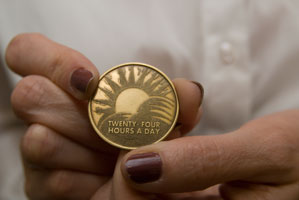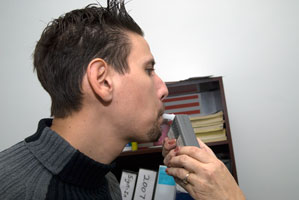|
March/April 2008 Issue Doing Time Wisely
The Lee Day Report Center (LDRC) serves a four-county area in West Virginia and brings together the community, victims, and offenders. Offenders receive sanctions, but they also receive services aimed at reducing recidivism while allowing them to live in the community. The LDRC is no “get out of jail free card,” according to Fred McDonald, MSW, the LDRC director and executive director of the Northern Panhandle Community Criminal Justice Board. “We are not loved by everyone. Some people look at us and say, ‘The criminal got an easy sentence.’ They don’t understand that these are people who are going to get home confinement or probation anyhow. We are adding a component of intensive supervision to their sanctions.”
Lulla relates the case of Gary*, who graduated from the program a few months ago. Gary had a history of stealing cars, but when he began abusing drugs, his life spiraled out of control. According to McDonald, approximately 90% of the people at the LDRC have substance abuse problems. “Gary came in writing bad checks and with an extremely bad attitude. Semicombative, he viewed things pretty much as a joke,” Lulla says. Gary’s intent was to skate by, but after several months of positive drug screens, he was sent to the regional jail where he remained for several months.
“Gary ended up finding out that all the people he was fighting against in this world were the ones that were truly trying to help him. They were trying to empower him to do something better with his life,” Lulla says. At the time of his release from the program, Gary was a group leader and was considering going back to school. Lulla says there is more needed than just jail time to treat substance abuse offenders. “We try to address the problem of the continued reciprocal cycle of use: commit a crime, go back to prison, come out, go back to using, and commit another crime. It is a vicious cycle that goes on over and over again. We try to eliminate the propensity for recidivism by eliminating the user’s going out and committing crimes to support the drug habit,” he says. Taking people off the street and failing to treat their substance abuse dependency ignores the cause of stealing, writing bad checks, and other crimes. Renee Stock, MSW, an intern at the LDRC, comments on jail time as a consequence for behavior: “Jail time and house confinement are consequences for using drugs or if you commit other crimes while in the community. Jail time is a deterrent, and that works well with all of the support and treatment that offenders receive at the LDRC.”
McDonald recalls the case of Doug*, who served two sentences in prison for driving under the influence before coming to the LDRC. Facing his third possible imprisonment, he was asked by the judge if he had ever received treatment and his answer was no. “He gave him a one- to three-[year sentence] and allowed him to serve it at home on home confinement. In addition to the home confinement, he ordered Doug to the LDRC for treatment and ordered a SCRAM [Secure Continuous Remote Alcohol Monitor] unit. A SCRAM unit is a bracelet worn on the offender’s ankle that tests for alcohol 24 hours a day. For two years, we had Doug on the SCRAM unit and on house arrest. He finished a full year at the LDRC and became a group leader. The treatment with the intensive monitoring along with the restrictions helped him.” In many cases, people such as Gary and Doug are our neighbors. As McDonald points out, we cannot build prisons fast enough to house such people, and having them serve time in the community results in large cost savings. It costs $48.50 a day per person for jail. Having offenders serve time in the community saved one county more than $500,000 per year. It also enables offenders to get treatment and leaves a prison cell available for a dangerous criminal. “We need to lock up the people we are afraid of, not the people we are mad at. Lock up the violent offenders,” McDonald says. * Name changed to protect anonymity. — Neal A. Newfield, PhD, ACSW, is an associate professor of social work and a documentary photographer with the division of social work at West Virginia University. |

 The chorus to the song “Don’t Do the Crime” by Snoop Dogg warns, “Don’t do the crime if you can’t do the time. Yeah, don’t do it.” According to Political Research Associates, 2.2 million people are doing time in the United States. The incarceration rate is 726 prisoners per 100,000 people, making us first [first where? MM checking] in the number of incarcerated individuals as we outgrow our prisons and jails. Who should serve time, what is effective time served, and should the time be served behind bars are questions that demand answers.
The chorus to the song “Don’t Do the Crime” by Snoop Dogg warns, “Don’t do the crime if you can’t do the time. Yeah, don’t do it.” According to Political Research Associates, 2.2 million people are doing time in the United States. The incarceration rate is 726 prisoners per 100,000 people, making us first [first where? MM checking] in the number of incarcerated individuals as we outgrow our prisons and jails. Who should serve time, what is effective time served, and should the time be served behind bars are questions that demand answers. Stephen Lulla, BS, an LDRC counselor and a certified criminal justice professional, supports this point of view. “A lot of times, I think people assume jail is the end to the problem. What they don’t realize is you can incarcerate somebody, but if you do not address the problem of why they were incarcerated now, you will have to address it later,” he explains. “You can either try to deal with it as we speak or you can keep people in jail but eventually, they are going to end up being released and the problem will be staring us back in the face.”
Stephen Lulla, BS, an LDRC counselor and a certified criminal justice professional, supports this point of view. “A lot of times, I think people assume jail is the end to the problem. What they don’t realize is you can incarcerate somebody, but if you do not address the problem of why they were incarcerated now, you will have to address it later,” he explains. “You can either try to deal with it as we speak or you can keep people in jail but eventually, they are going to end up being released and the problem will be staring us back in the face.” According to Lulla, Gary found that in retrospect, jail was the “kick in the pants” he needed. Gary realized he did not want to spend the rest of his life going in and out of institutions and came to grips with his upbringing. While he got everything he needed materially from his parents, he did not receive the necessary supervision and discipline.
According to Lulla, Gary found that in retrospect, jail was the “kick in the pants” he needed. Gary realized he did not want to spend the rest of his life going in and out of institutions and came to grips with his upbringing. While he got everything he needed materially from his parents, he did not receive the necessary supervision and discipline. The LDRC has a day program that runs from 8 am to noon and an evening program from 5:30 pm to 9:30 pm for those who are employed. Most services are provided in a group format, although there is time for individually tailored treatment. There are substance abuse groups specifically designed for criminal offenders, relapse prevention, “Big Book,” women’s recovery, and drug and alcohol education. Non–substance abuse-oriented activities include interactive journaling, a parenting program, a batterer’s intervention/prevention group, and career and educational opportunities groups. Drug testing is conducted regularly and randomly.
The LDRC has a day program that runs from 8 am to noon and an evening program from 5:30 pm to 9:30 pm for those who are employed. Most services are provided in a group format, although there is time for individually tailored treatment. There are substance abuse groups specifically designed for criminal offenders, relapse prevention, “Big Book,” women’s recovery, and drug and alcohol education. Non–substance abuse-oriented activities include interactive journaling, a parenting program, a batterer’s intervention/prevention group, and career and educational opportunities groups. Drug testing is conducted regularly and randomly.